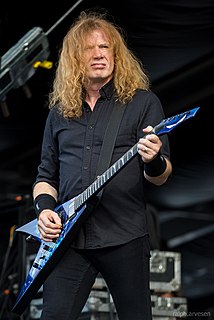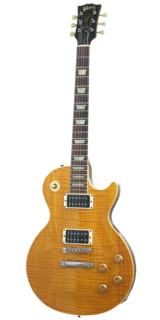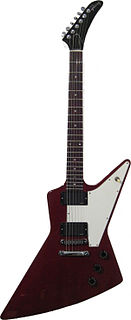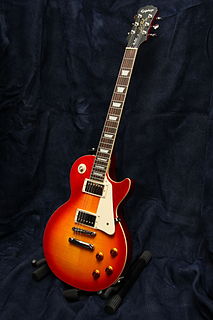Related Research Articles

David Scott Mustaine is an American musician best known as the co-founder, vocalist, guitarist, and primary songwriter of thrash metal band Megadeth. Prior to forming Megadeth, Mustaine was the original lead guitarist of heavy/thrash metal band Metallica, co-writing at least six released Metallica songs but not appearing on any of their albums.

The Gibson SG is a solid-body electric guitar model introduced by Gibson in 1961 as the Gibson Les Paul SG. It remains in production today in many variations of the initial design. The SG Standard is Gibson's best-selling model of all time.

The Gibson Les Paul is a solid body electric guitar that was first sold by the Gibson Guitar Corporation in 1952. The Les Paul was designed by Gibson president Ted McCarty, factory manager John Huis and their team with input from and endorsement by guitarist Les Paul. Its typical design features a solid mahogany body with a carved maple top and a single cutaway, a mahogany set-in neck with a rosewood fretboard, two pickups with independent volume and tone controls, and a stoptail bridge, although variants exist.

The Gibson ES-335 is the world's first commercial semi-hollowbody electric guitar, sometimes known as semi-acoustic. Released by the Gibson Guitar Corporation as part of its ES series in 1958, it is neither fully hollow nor fully solid; instead, a solid maple wood block runs through the center of its body. The side "wings" formed by the two "cutaways" into its upper bouts are hollow, and the top has two violin-style f-holes over the hollow chambers. Since its release, Gibson has released numerous variations of and other models based on the design of the ES-335.

ESP Company, Limited is a Japanese guitar manufacturer, primarily focused on the production of electric guitars and basses. They are based in both Tokyo and Los Angeles, with distinct product lines for each market. ESP Company manufactures instruments under several names, including "ESP Standard", "ESP Custom Shop", "LTD Guitars and Basses", "Navigator", "Edwards Guitars and Basses", and "Grassroots". Their products range from Japanese-built custom shop instruments to lower end mass-production Korean, Indonesian and Chinese made instruments.

The Fender Telecaster Deluxe is a solid-body electric guitar originally produced from 1972 to 1981, and re-issued by Fender multiple times starting in 2004.

The Gibson Flying V is an electric guitar model introduced by Gibson in 1958. The Flying V offered a radical, "futuristic" body design, much like its siblings: the Explorer, which was released the same year and the Moderne, which was designed in 1957 but not released until 1982. The initial run of guitars used a distinctive wood of the Limba tree marketed by Gibson under the trade name "korina"; later models used more conventional woods.

The Gibson Explorer is a type of electric guitar that made its debut in 1958. The Explorer offered a radical, "futuristic" body design, much like its siblings: the Flying V, which was released the same year, and the Moderne, which was designed in 1957 but not released until 1982. The Explorer was the final development of a prototype design that, years later, Gibson marketed under the name Futura.
The King V is an electric guitar made by Jackson Guitars.
The Jackson Soloist is an electric guitar model by Jackson Guitars officially produced since 1984. Overall design started as a superstrat with differences from the Stratocaster such as a neck-thru design and often a Floyd Rose double-locking tremolo bridge and premium woods.

The Gibson Hummingbird is an acoustic guitar model/series produced by the Gibson Guitar Corporation.

The Gibson Thunderbird is an electric bass guitar made by Gibson and Epiphone.
A solid-body musical instrument is a string instrument such as a guitar, bass or violin built without its normal sound box and relying on an electromagnetic pickup system to directly detect the vibrations of the strings; these instruments are usually plugged into an instrument amplifier and loudspeaker to be heard. Solid-body instruments are preferred in situations where acoustic feedback may otherwise be a problem and are inherently both less expensive to build and more rugged than acoustic electric instruments.
The Gibson Melody Maker is an electric guitar made by Gibson Guitar Corporation. It has had many body shape variations since its conception in 1959.

The Gibson J-45 is a dreadnought style acoustic guitar manufactured by the Gibson Guitar Corporation. It is generally regarded as Gibson's most famous and widely used acoustic guitar model.

The Gibson L6-S is a solid body electric guitar. It was the working musician's descendant of the L5S jazz solid-body electric guitar. It was the same shape, very much like a wide Gibson Les Paul, but with a 24-fret two-octave neck, the first Gibson guitar to have this.

The Ibanez Iceman is a guitar produced by Hoshino Gakki under Ibanez brand.
The Gibson ES series of semi-acoustic guitars are manufactured by the Gibson Guitar Corporation.

The Epiphone Les Paul is a solid body guitar line produced by Epiphone as a more modestly priced version of the famous Gibson Les Paul. Epiphone is a subsidiary of Gibson Guitar Corporation and manufactures the Les Paul model and other budget models at a lower cost in Asia.
The Fender Telecaster, colloquially known as the Tele, is the world's first commercially successful solid-body electric guitar. Its simple yet effective design and revolutionary sound broke ground and set trends in electric guitar manufacturing and popular music. Introduced for national distribution as the Broadcaster in the autumn of 1950 as a two-pickup version of its sister model, the single-pickup Esquire, the pair were the first guitars of their kind manufactured on a substantial scale. A trademark conflict with a rival manufacturer's led to the guitar being renamed in 1951. Initially, the Broadcaster name was simply cut off of the labels placed on the guitars and later in 1951, the final name of Telecaster was applied to the guitar. The Telecaster quickly became a popular model, and has remained in continuous production since its first incarnation.
References
- ↑ Jackson Guitar Palace
- ↑ Jackson Catalog 2001. Tuners are arranged in the classic 3-a side style instead of the usual six a side. These two differences combined result in a guitar with high levels of sustain. Archived 2010-01-02 at the Wayback Machine